Rs Aggarwal Solutions: Exercise 1H - Rational Numbers | Mathematics (Maths) Class 8 PDF Download
Q.1. Tick (✓) the correct answer
-516+712=?
(a) -748
(b) 124
(c) 1348
(d) 13
Ans.
(c) 1348
The denominators of the given rational numbers are 16 and 12, respectively.
LCM of 16 and 12 is 4×4×3, that is,48
Now, we have:
- 516 + 712=3 × -5 + 4 × 748
= -15 + 2848 = 1348
Q.2. Tick (✓) the correct answer
(a)
(b)
(c)
(d)
Ans.
(b)

Now, we have:
LCM of 15 and 3 is (3 x 5 x 1), that is,15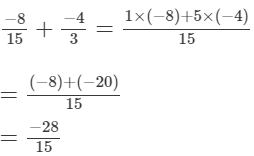
Q.3. Tick (✓) the correct answer
(a)
(b)
(c)
(d)
Ans.
Now, we have:
LCM of 26 and 39 is 1014, that is, (29 x 1 x 36).
(a)

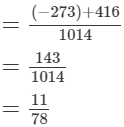
Q.4. Tick (✓) the correct answer
(a)
(b) 
(c)
(d)
Ans.
(b) 

Now, we have:
LCM of 1 and 7 is 7

Q.5. Tick (✓) the correct answer
(a)
(b)
(c)
(d)
Ans.
(d)

We have:
LCM of 4 and 8 is 8, that is, (4 x 1 x 2).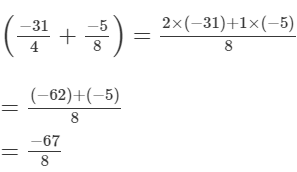
Q.6. Tick (✓) the correct answer
What should be added to 
(a) 
(b)
(c)
(d)
Ans.
(b)
Let the required number be x.
Now,

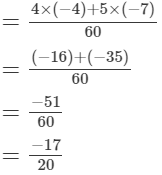
Q.7. Tick (✓) the correct answer
(a) 
(b)
(c)
(d) 
Ans.
(c)
Using the commutative and associative laws, we can arrange the terms in any suitable manner. Using this rearrangement property, we have:
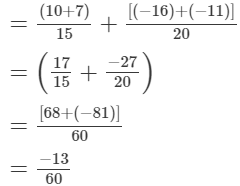
Q.8. Tick (✓) the correct answer
The sum of two numbers is  If one of the numbers is −5, what is the other?
If one of the numbers is −5, what is the other?
(a)
(b)
(c)
(d)
Ans.
(b)
Let the other number be x.
Now,

Q.9. Tick (✓) the correct answer
What should be added to 
(a)
(b)
(c)
(d)
Ans.
(c)  Let the required number be x.
Let the required number be x.
Now,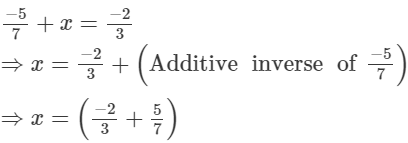

Q.10. Tick (✓) the correct answer
What should be subtracted from 
(a) 
(b) 
(c)
(d)
Ans.
(d)
Let the required number be x.
Now,

Thus, the required number is 
Q.11. Tick (✓) the correct answer
(a)
(b)
(c)
(d) none of these
Ans.
(b)

The reciprocal of 
Q.12. Tick (✓) the correct answer
The product of two rational numbers is  If one of the numbers is
If one of the numbers is then the other one is
then the other one is
(a)
(b)
(c)
(d)
Ans.
(a) 
Let the other number be x.
Now,
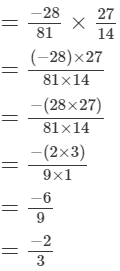
Thus, the other number is 
Q.13. Tick (✓) the correct answer
The product of two numbers is  If one of the numbers is
If one of the numbers is  the other is
the other is
(a) 
(b)
(c)
(d)
Ans.
(c) 
Let the other number be x.
Now,
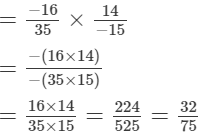
Thus, the other number is
Q.14. Tick (✓) the correct answer
What should be subtracted from 
(a)
(b) 
(c) 
(d)
Ans.
(d)
Let the required number be x.
Now,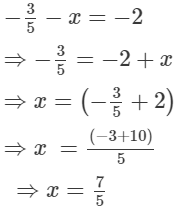
Thus, the required number is
Q.15. Tick (✓) the correct answer
The sum of two rational numbers is −3. If one of them is  then the other one is
then the other one is
(a)
(b)
(c)
(d)
Ans.
(c)
Let the other number be x.
Now,
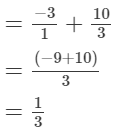
Thus, the other number is 1/3.
Q.16. Tick (✓) the correct answer
Which of the following numbers is in standard form?
(a)
(b)
(c)
(d)
Ans.
The numbers  are in the standard form because they have no common divisor other than 1 and their denominators are positive.
are in the standard form because they have no common divisor other than 1 and their denominators are positive.
Q.17.
Tick (✓) the correct answer
(a)
(b)
(c)
(d)
Ans.
(a)


Q.18. Tick (✓) the correct answer
(a)
(b)
(c)
(d)
Ans.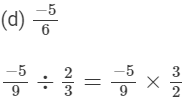

Q.19. Tick (✓) the correct answer
(a)
(b)
(c)
(d) 
Ans.
(d) 

Now,
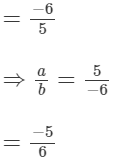
Hence, the missing number is 
Q.20. Tick (✓) the correct answer
Additive inverse of  is
is
(a)
(b) 0
(c)
(d) 
Ans.
(c)
Additive inverse of 
Q.21. Tick (✓) the correct answer
Reciprocal of  is
is
(a) 
(b)
(c)
(d) 0
Ans.
Reciprocal of 
Q.22. Tick (✓) the correct answer
A rational number between  is
is
(a)
(b)
(c)
(d)
Ans.
(d)
Rational number between 
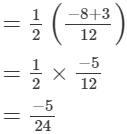
Q.23. Tick (✓) the correct answer
The reciprocal of a negative rational number
(a) is a positive rational number
(b) is a negative rational number
(c) can be either a positive or a negative rational number
(d) does not exist
Ans.
(b) is a negative rational number
The reciprocal of a negative rational number is a negative rational number.
|
81 videos|423 docs|31 tests
|





















